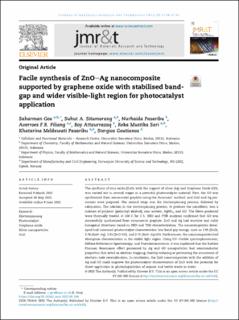| dc.contributor.author | Saharman, Gea | |
| dc.contributor.author | Situmorang, Suhut Alexander | |
| dc.contributor.author | Pasaribu, Nurhaida | |
| dc.contributor.author | Piliang, Averroes FR | |
| dc.contributor.author | Attaurrazaq, Boy | |
| dc.contributor.author | Sari, Reka Mustika | |
| dc.contributor.author | Pasaribu, Khatarina Meldawati | |
| dc.contributor.author | Goutianos, Stergios | |
| dc.date.accessioned | 2022-11-29T07:02:37Z | |
| dc.date.available | 2022-11-29T07:02:37Z | |
| dc.date.created | 2022-11-01T23:49:50Z | |
| dc.date.issued | 2022 | |
| dc.identifier.citation | Journal of Materials Research and Technology (JMR&T). 2022, 19, 2730-2741. | en_US |
| dc.identifier.issn | 2238-7854 | |
| dc.identifier.uri | https://hdl.handle.net/11250/3034598 | |
| dc.description.abstract | The synthesis of zinc oxide (ZnO), with the support of silver (Ag) and Graphene Oxide (GO), was carried out in several stages as a potential photocatalytic material. First, the GO was synthesized from commercial graphite using the Hummers’ method, and ZnO and Ag precursors were prepared. The second stage was the electrospinning process, followed by calcination. The solution in the electrospinning process, to produce the nanofibers, was a mixture of polymer (polyvinyl alcohol), zinc acetate, AgNO3, and GO. The fibres produced were thermally treated at 500 C for 2 h. XRD and FTIR analyses confirmed that GO was successfully synthesized from commercial graphite. ZnO and Ag had wurtzite and cubic hexagonal structures based on XRD and TEM characterization. The nanocomposites developed had increased photocatalyst characteristics: low band gap energy, such as 2.98 (ZnO), 2.76 (ZnO–Ag), 2.93 (ZnO-GO), and 2.75 (ZnO–Ag-GO). Furthermore, the nanocomposites had absorption characteristics in the visible light region. Using UV–Visible spectrophotometer, Diffuse Reflectance Spectroscopy, and Photoluminescence, it was explained that the Surface Plasmon Resonance effect possessed by Ag and GO nanoparticles had semiconductor properties that acted as electron trapping, thereby reducing or preventing the occurrence of electron–hole recombination. In conclusion, the ZnO nanocomposites with the addition of Ag and GO could improve the photocatalytic characteristics of ZnO with the potential for direct application in photodegradation of organic and textile waste in water. | en_US |
| dc.language.iso | eng | en_US |
| dc.publisher | Elsevier Science | en_US |
| dc.rights | Attribution-NonCommercial-NoDerivatives 4.0 Internasjonal | * |
| dc.rights.uri | http://creativecommons.org/licenses/by-nc-nd/4.0/deed.no | * |
| dc.title | Facile synthesis of ZnO–Ag nanocomposite supported by graphene oxide with stabilised band-gap and wider visible-light region for photocatalyst application | en_US |
| dc.title.alternative | Facile synthesis of ZnO–Ag nanocomposite supported by graphene oxide with stabilised band-gap and wider visible-light region for photocatalyst application | en_US |
| dc.type | Peer reviewed | en_US |
| dc.type | Journal article | en_US |
| dc.description.version | publishedVersion | en_US |
| dc.source.pagenumber | 2730-2741 | en_US |
| dc.source.volume | 19 | en_US |
| dc.source.journal | Journal of Materials Research and Technology (JMR&T) | en_US |
| dc.identifier.doi | https://doi.org/10.1016/j.jmrt.2022.05.184 | |
| dc.identifier.cristin | 2067651 | |
| cristin.ispublished | true | |
| cristin.fulltext | original | |
| cristin.qualitycode | 1 | |

